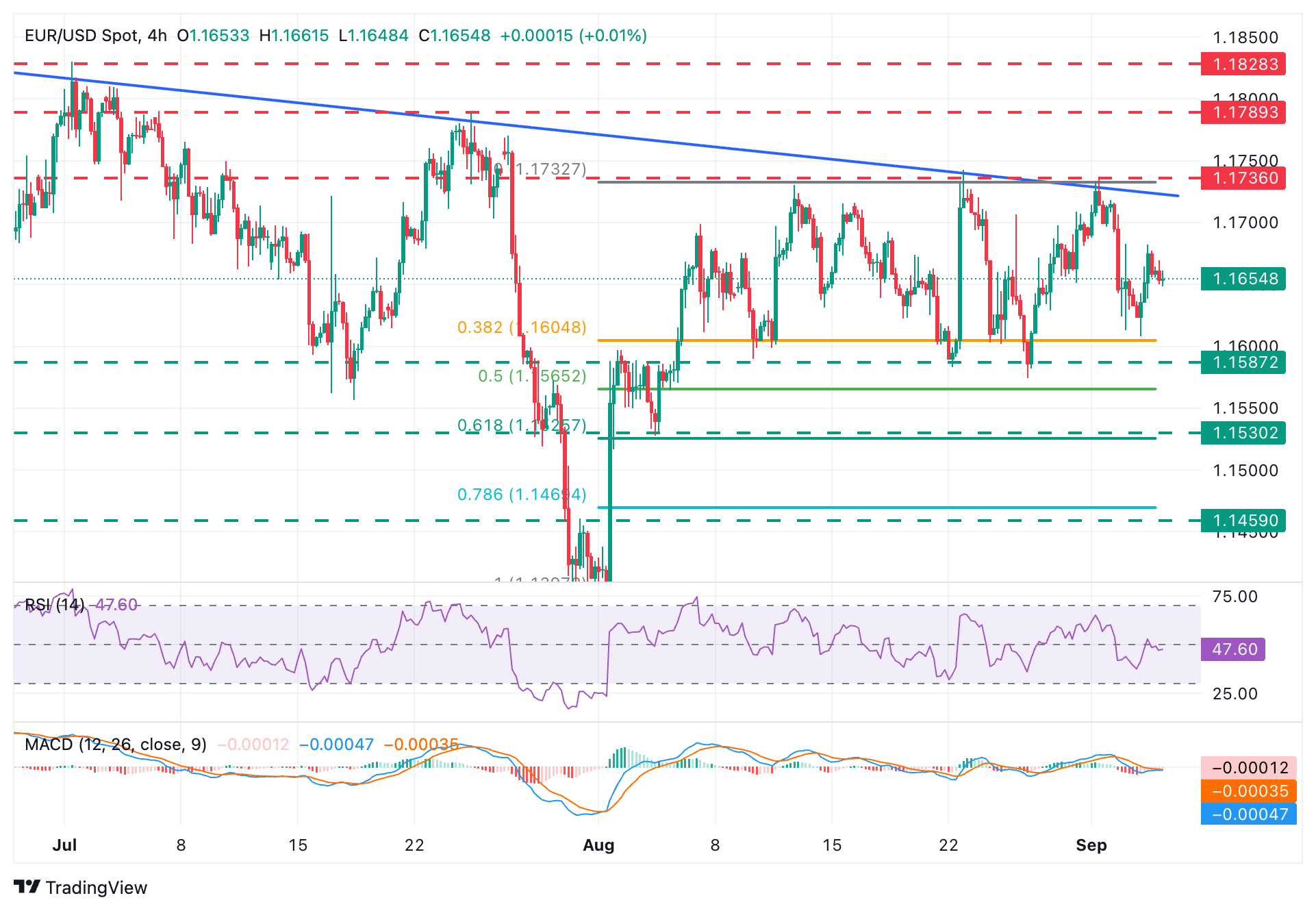Created
: 2025.09.04













![]() 2025.09.04 16:35
2025.09.04 16:35
The EUR/USD pair trades with minor losses at 1.1650 at the opening of the European session on Thursday. The pair keeps looking for direction, not far from the lower end of the last few weeks' trading range, ahead of the Eurozone's Retail Sales report. However, the main focus is on the US ADP Employment Change, due later in the day and, above all, on Friday's US Nonfarm Payrolls report.
On Wednesday, the weak US JOLTS Job Openings data added to evidence of a weak labor market and boosted expectations of immediate Federal Reserve (Fed) interest rate cuts. This view was confirmed by Fed speakers like Governor Christopher Waller and Atlanta Fed President Raphael Bostic later on.
Investors' bets on Fed easing in the upcoming September meeting surged to 97%, from about 87% in the previous day, which calmed fears about the ballooning fiscal debt in the world's major economies that had gripped markets earlier in the week. The US 30-year bond yield retreated below 4.90% from Wednesday's highs at 5% while, in Europe, the long-term German Bund yield eased to 3.35% from multi-year highs at 3.43%.
The market mood, however, remains cautious. The focus today is on the US ADP Employment report, which is expected to show relatively low employment creation ahead of Friday's Nonfarm Payrolls. The last might confirm a 25 basis points rate cut after the September 17 Federal Market Open Committee (FOMC) meeting.
The table below shows the percentage change of Euro (EUR) against listed major currencies today. Euro was the strongest against the Australian Dollar.
| USD | EUR | GBP | JPY | CAD | AUD | NZD | CHF | |
|---|---|---|---|---|---|---|---|---|
| USD | 0.03% | 0.09% | 0.07% | 0.13% | 0.25% | 0.06% | 0.03% | |
| EUR | -0.03% | 0.07% | 0.00% | 0.10% | 0.28% | 0.03% | -0.04% | |
| GBP | -0.09% | -0.07% | 0.04% | 0.03% | 0.20% | -0.03% | -0.12% | |
| JPY | -0.07% | 0.00% | -0.04% | 0.09% | 0.13% | 0.05% | -0.01% | |
| CAD | -0.13% | -0.10% | -0.03% | -0.09% | 0.09% | -0.06% | -0.14% | |
| AUD | -0.25% | -0.28% | -0.20% | -0.13% | -0.09% | -0.24% | -0.31% | |
| NZD | -0.06% | -0.03% | 0.03% | -0.05% | 0.06% | 0.24% | -0.03% | |
| CHF | -0.03% | 0.04% | 0.12% | 0.01% | 0.14% | 0.31% | 0.03% |
The heat map shows percentage changes of major currencies against each other. The base currency is picked from the left column, while the quote currency is picked from the top row. For example, if you pick the Euro from the left column and move along the horizontal line to the US Dollar, the percentage change displayed in the box will represent EUR (base)/USD (quote).

EUR/USD has shrugged off the bearish pressure seen earlier in the week, but it is not out of the woods yet. Investors' mood remains cautious with long-term yields still near historic highs and France's uncertain political scenario weighing. Technical indicators show a lack of clear bias, but the bottom of the last four weeks' trading range, in the 1.1585 area, remains at a relatively short distance.
Immediate support is at Wednesday's low, near 1.1610, ahead of the key support area between 1.1575 and 1.1590, which capped bears on August 11, 22 and 27. Further down, the 50% Fibonacci retracement level of the early August bullish run, at 1.1565, might provide some support ahead of the August 5 low, near 1.1530.
To the upside, Wednesday's high of 1.1682 is the first hurdle for bulls ahead of the descending trendline resistance, now around 1.1725 and the 1.1735 area, which held bulls on August 13 and 22, and September 1.
The Euro is the currency for the 19 European Union countries that belong to the Eurozone. It is the second most heavily traded currency in the world behind the US Dollar. In 2022, it accounted for 31% of all foreign exchange transactions, with an average daily turnover of over $2.2 trillion a day. EUR/USD is the most heavily traded currency pair in the world, accounting for an estimated 30% off all transactions, followed by EUR/JPY (4%), EUR/GBP (3%) and EUR/AUD (2%).
The European Central Bank (ECB) in Frankfurt, Germany, is the reserve bank for the Eurozone. The ECB sets interest rates and manages monetary policy. The ECB's primary mandate is to maintain price stability, which means either controlling inflation or stimulating growth. Its primary tool is the raising or lowering of interest rates. Relatively high interest rates - or the expectation of higher rates - will usually benefit the Euro and vice versa. The ECB Governing Council makes monetary policy decisions at meetings held eight times a year. Decisions are made by heads of the Eurozone national banks and six permanent members, including the President of the ECB, Christine Lagarde.
Eurozone inflation data, measured by the Harmonized Index of Consumer Prices (HICP), is an important econometric for the Euro. If inflation rises more than expected, especially if above the ECB's 2% target, it obliges the ECB to raise interest rates to bring it back under control. Relatively high interest rates compared to its counterparts will usually benefit the Euro, as it makes the region more attractive as a place for global investors to park their money.
Data releases gauge the health of the economy and can impact on the Euro. Indicators such as GDP, Manufacturing and Services PMIs, employment, and consumer sentiment surveys can all influence the direction of the single currency. A strong economy is good for the Euro. Not only does it attract more foreign investment but it may encourage the ECB to put up interest rates, which will directly strengthen the Euro. Otherwise, if economic data is weak, the Euro is likely to fall. Economic data for the four largest economies in the euro area (Germany, France, Italy and Spain) are especially significant, as they account for 75% of the Eurozone's economy.
Another significant data release for the Euro is the Trade Balance. This indicator measures the difference between what a country earns from its exports and what it spends on imports over a given period. If a country produces highly sought after exports then its currency will gain in value purely from the extra demand created from foreign buyers seeking to purchase these goods. Therefore, a positive net Trade Balance strengthens a currency and vice versa for a negative balance.
![]()
Created
: 2025.09.04
![]()
Last updated
: 2025.09.04

FXStreet is a forex information website, delivering market analysis and news articles 24/7.
It features a number of articles contributed by well-known analysts, in addition to the ones by its editorial team.
Founded in 2000 by Francesc Riverola, a Spanish economist, it has grown to become a world-renowned information website.
We hope you find this article useful. Any comments or suggestions will be greatly appreciated.
We are also looking for writers with extensive experience in forex and crypto to join us.
please contact us at [email protected].
Disclaimer:
All information and content provided on this website is provided for informational purposes only and is not intended to solicit any investment. Although all efforts are made in order to ensure that the information is correct, no guarantee is provided for the accuracy of any content on this website. Any decision made shall be the responsibility of the investor and Myforex does not take any responsibility whatsoever regarding the use of any information provided herein.
The content provided on this website belongs to Myforex and, where stated, the relevant licensors. All rights are reserved by Myforex and the relevant licensors, and no content of this website, whether in full or in part, shall be copied or displayed elsewhere without the explicit written permission of the relevant copyright holder. If you wish to use any part of the content provided on this website, please ensure that you contact Myforex.
Myforex uses cookies to improve the convenience and functionality of this website. This website may include cookies not only by us but also by third parties (advertisers, log analysts, etc.) for the purpose of tracking the activities of users. Cookie policy